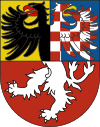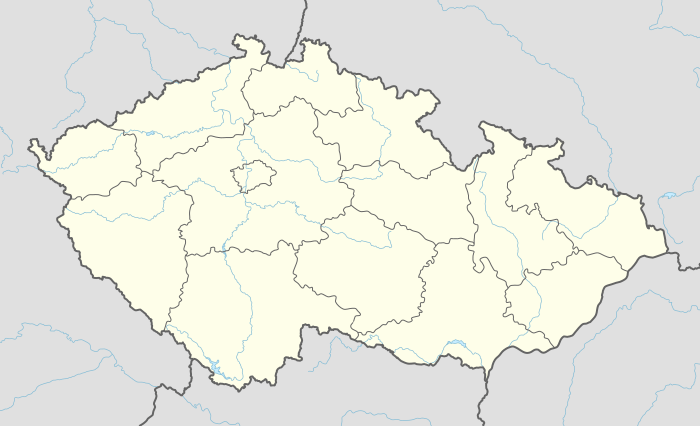Slavkov u Brna
Slavkov u Brna (Czech pronunciation: [ˈslafkof ˈu br̩na], i.e. Slavkov by Brno; historically known in German as Austerlitz) is a country town east of Brno in the South Moravian Region of the Czech Republic. The population of the town is approximately 6,700. The town gave its name to the Battle of Austerlitz which took place several kilometres to the west of the town.
Slavkov u Brna | |
|---|---|
Town | |
.jpg) Aerial view | |
 Flag  Coat of arms | |
 Slavkov u Brna Location in the Czech Republic | |
| Coordinates: 49°9′12″N 16°52′35″E | |
| Country | Czech Republic |
| Region | South Moravian |
| District | Vyškov |
| First mentioned | 1237 |
| Government | |
| • Mayor | Michal Boudný |
| Area | |
| • Total | 14.95 km2 (5.77 sq mi) |
| Elevation | 211 m (692 ft) |
| Population (2019-01-01[1]) | |
| • Total | 6,694 |
| • Density | 450/km2 (1,200/sq mi) |
| Time zone | UTC+1 (CET) |
| • Summer (DST) | UTC+2 (CEST) |
| Postal code | 684 01 |
| Website | www.slavkov.cz |
History
At the beginning of the 13th century, the Teutonic Order built a monastery stronghold whose remains can still be seen today in the vaults of the Austerlitz Palace. The first written testimony about the place date from 1237. The Czech name Slavkov is first documented in 1361, the German name Austerlitz in 1633. After the defeat of the Order in the Battle of Grunwald, the town became the property of a number of noble owners until, in 1509, the local noble family of Kaunitz assumed control for more than 400 years.
Sightseeing
- Baroque Slavkov Castle has 115 rooms and an impressive garden in the French style. The Palace was designed by Italian architect Domenico Martinelli. In its historic salon, an armistice was signed between Austria and France after the battle of Austerlitz on 2 December, 1805. There is a small historic museum (only in Czech) and a multimedia presentation about the battle.
- On the main square is a late Renaissance town hall and mansion. Parts of the old town wall can also be seen.
- Church of the Resurrection of the Lord (on the south side of the main square). The classicist building with three pulpits was designed from 1786–1789 by the Viennese architect Johann Ferdinand Hetzendorf von Hohenberg.
- Church of St. John the Baptist (in the cemetery). Beneath the church is a vault which contains the tombs of the Kaunitz family.
- Chapel of St. Urbanus (to the north on the Urbanus hill). The chapel of 1712 was badly damaged during the battle of Austerlitz and had to be rebuilt during 1858–1861.
- Jewish Heritage. Only the synagogue (built in 1858) remains from the Jewish ghetto. There is also a Jewish cemetery a little bit outside the town. "Austerlitz" is a Jewish family name, of which the bearers are nowadays spread worldwide but which indicate and ultimate family origin in the town – see Austerlitz (family). The dancer Fred Astaire was born Fred Austerlitz, and thus it could be assumed that his ancestors lived in this town.
Monuments and sights of the Battle of Austerlitz
The Battle of Austerlitz actually took place several kilometers to the west of Austerlitz. Public transport to the site is limited, and the landscape has preserved its bucolic aspect. Agriculture still dominates the hilly terrain which has not changed much (apart from the sprawl of the villages). A highway bisects the battlefield.
- The Old Post (Stará pošta) in Kovalovice is an original building dating from 1785, which now serves as a hotel and restaurant. On 28 November 1805, the French cavalry general Murat set up his headquarters here. On the day of the battle, the Russian general Bagration had his headquarters here. After the battle, Napoleon slept in this house and held preliminary negotiations about an armistice. A small museum commemorates these events.
- On Santon hill to east of Tvarožná village is a small white chapel. The hill was a mainstay of the French position and allowed the French artillery to dominate the northern portion of the battlefield. Below the hill, the yearly historical reenactments take place.
- On Žuráň Hill Napoleon Bonaparte had his headquarters. A granite monument depicts the battlefield positions.
- In Šlapanice a number of mass graves with a monument can be seen.
- The Peace Memorial (Mohyla míru) on Prace hill. The memorial near Prace was designed and built in the Art-Nouveau style by Josef Fanta, an architect from Prague, during 1910 to 1912. The First World War postponed the monument's dedication until 1923. It is 26 m high, square, with four female statues symbolizing France, Austria, Russia and Moravia. Within is a chapel with an ossuary. A small museum commemorates the battle. Every year, the events of the battle of Austerlitz are commemorated in a ceremony.
- Near Křenovice village stands a weathered peace cross.
- The Old Vineyards (Staré vinohrady) near Blažovice saw the bloody collision of the French and Russian guards. In 2005, a new Monument to the Three Emperors has been erected.
Trivia
Much in the same way that in London, the English have named Waterloo Station to commemorate their victory at Waterloo, the French gave the name of Austerlitz to one of the major Parisian train stations, the Gare d'Austerlitz. There is also a Quai d'Austerlitz in the 13th arrondissement of Paris. In the Netherlands a small village was founded in commemoration of the battle, see: Austerlitz (Netherlands).
Gallery
 Slavkov Castle
Slavkov Castle Town hall and the police station at the town square
Town hall and the police station at the town square Synagogue
Synagogue Front view of the Austerlitz Palace (with stalls during the 200th anniversary of the battle of Austerlitz)
Front view of the Austerlitz Palace (with stalls during the 200th anniversary of the battle of Austerlitz)- Church of the Resurrection
 St. Urbanus Chapel on a hill over the town
St. Urbanus Chapel on a hill over the town Santon Hill (with visitors during the 200th anniversary)
Santon Hill (with visitors during the 200th anniversary) The Peace Memorial
The Peace Memorial The cupola of the Peace Memorial
The cupola of the Peace Memorial Interior of the Peace Memorial with wreaths commemorating the 200th anniversary
Interior of the Peace Memorial with wreaths commemorating the 200th anniversary Monument to the Three Emperors at the Old Vineyards
Monument to the Three Emperors at the Old Vineyards Austerlitz Palace seen from the park at dusk
Austerlitz Palace seen from the park at dusk Austerlitz castle park in French baroque style
Austerlitz castle park in French baroque style
Notable people
- Austerlitz (family)
- František Koláček (1851–1913), Czech physicist
- Peregrin Obdržálek (1825–1891), a Catholic priest, founder of libraries, mutual savings banks and farm associations, also an author of religious literature, satire, humorous tales and poems
- Ladislav Benesch (1845–1922), Austro-Hungarian officer, painter
References
- "Population of municipalities of the Czech republic". Czech Statistical Office. Retrieved 2019-04-30.
External links
| Wikimedia Commons has media related to Slavkov u Brna. |
| Wikisource has several original texts related to: Slavkov u Brna |